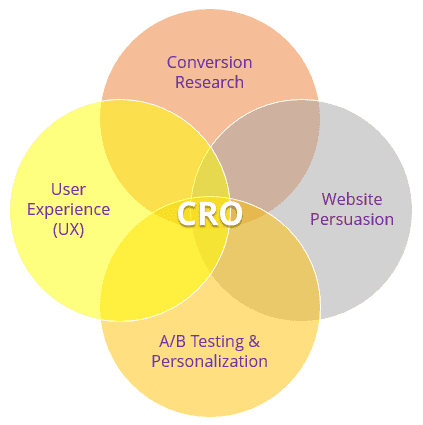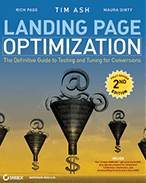How to Improve Your Website If Your Traffic is Too Low for A/B Testing
Last updated |
Frustrated because you want to do A/B testing to improve your website, but don’t have enough traffic?
You are not alone. One of the questions I receive most from businesses is how to improve their website if their traffic is too low for A/B testing. So what can you do?
The good news is there are some things you can change when creating an A/B test that will mean you need less traffic.
And the best news is that you don’t actually need it for improving your website. This is because A/B testing is only one part of successful conversion rate optimization.
First, check if your traffic is too low to run an A/B test
Before we discuss other ways to improve your low traffic website, it’s obviously important to first understand if you actually have enough traffic, and to learn what else is important.
How much traffic do you need to run an A/B test on a web page?
To put it simply, you need at least 5,000 visitors per week to the page you want to run an A/B test on. If you don’t have this much traffic, it will take a long time (often months or never) for your A/B testing tool to gather enough data to find a statistically significant result. Use this handy A/B test length calculator to give you an idea of how many days it will take you to get a result. Also, the more page variations you test, the more traffic you will need to get a result. But you need something else too…
Is it just about having enough website traffic to run an A/B test?
Even more importantly, you also need enough ‘conversions’ on your website to run an A/B test. This is because to run a test, you need to tell the A/B testing tool what determines success, and this is usually a major goal like a purchase, a sign-up or a form completion. And the less conversions your website gets per week, the longer it will take the testing tool to find a winning result. As a guideline, your website needs at least 500 conversions per week for a simple A/B test (250 per test version).
Try these techniques if you don’t have enough traffic
Don’t have enough traffic? Don’t give up hope about trying to improve your website! You can still use some techniques to increase the chances of you being able to run an A/B test, or use some alternative approaches to give you similar insights and website improvement results. Here are some great techniques to try:
Use an engagement A/B test success metric instead of orders or sign-ups
Its not just about having enough traffic to run an A/B test – having enough conversions is even more important to be able to get a result. And you can define a conversion as something that happens more often – if you use a success metric that happens very frequently like a click to a specific page (like the next page in your checkout) instead of orders, this will count as many more conversions, and therefore much greater chance of being able to get a result from an A/B test.
This works particularly well on the homepages for increasing engagement, using any click as the A/B test success metric. Others that work well are using ‘adds to cart’ instead of completed checkouts, or clicks to the sign-up page instead of completed sign-ups.
Drive paid search to temporarily increase traffic to the page you want to test
One of the easiest ways to get more traffic to be able to do A/B testing is to spend money on Google Ads or Facebook Ads to the page you want to test. So if you can afford some extra budget for this, then I highly recommend you do this.
Do my ‘User-Focused A/B Testing’ technique which doesn’t require any traffic
My new technique helps you discover ‘why’ users prefer either your current page or a new version of it you are considering launching, not just ‘what’ version they prefer. And it doesn’t require lots of traffic like traditional A/B testing does.
And more importantly, it gives you great feedback and insights for creating high-impact website improvements, meaning a much better chance of increasing your website conversion rate and sales. Learn all about User-Focused A/B Testing.
Use Google Ads experiments to split test and find high-converting wording
With this technique, instead of creating an A/B test in a testing tool, you use Google Ads experiments to find which ad variations get most clicks on wording relating to the page you want to improve. This is ideal for testing wording for headlines, benefits, call-to-actions and other important words on your website.
To do this simply create a Google Ads experiment using a few different ads that emphasize different headlines and descriptions, let it run and see which has the highest conversion rate (see below for an example of an experiments report). Then once you have found the winning ad, replicate that winning ad text on the page you wanted to improve, and watch your conversions and sales grow.

Launch your improvements and then monitor impact on key metrics
This technique is where you simply launch the new improvement for one week and check the impact on key metrics like conversion rate or revenue. Then determine if there is a good improvement in comparison to the performance of the previous version. Then if the it performs better you keep it live and continue to monitor the impact. If it performs worse, then you roll back to the previous version.
Although you don’t get statistical significance with this method, it’s better than just launching new pages and hoping for the best. To reduce the chance of issues, while you are monitoring new improvement launches try not to make any major change in traffic source or any other major website changes that might impact your key metrics.
When doing this type of website improvement launches, the quality of your improvement idea is really important for determining success. Rather than just guessing, to increase the chances of success I suggest you get improvement ideas from CRO experts like myself.
You can still do CRO if you don’t have enough traffic for A/B testing
You may think you can’t do conversion rate optimization (CRO) to improve your website if you don’t have enough traffic for A/B testing. Many people even think that A/B testing and CRO are the same thing. Fortunately these thoughts are both wrong. But why?
It is because A/B testing isn’t essential for improving websites and is only one of the four main elements of CRO. Conversion research, user experience (UX), and website persuasion are the other key elements.
Learn about these other elements of CRO to help improve your website.
Wrapping Up
Ultimately you need to realize it’s not just about having enough traffic to do A/B testing, and that there are many other ways to find the best variations of your website.
Have you tried any of these techniques for running A/B tests on low traffic websites? Or which ones of these will you try first for your website?




